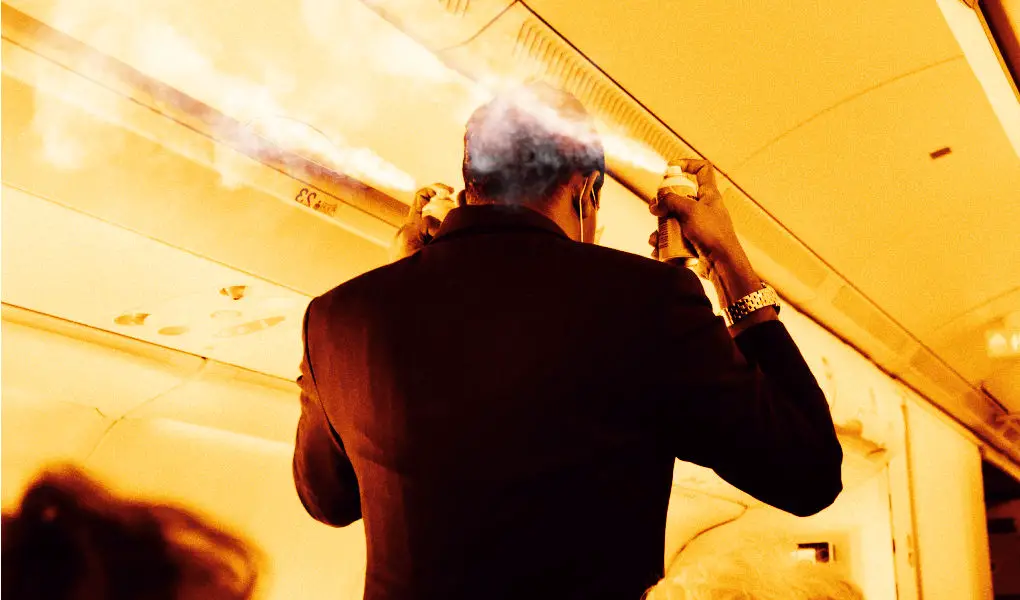Congratulations! You survived 14 hours of recycled air and questionable chicken—or so you thought. Just as you’re ready to touch down, the flight attendants unleash a mist of in-flight pesticide like they’re fumigating for the next biblical plague.
Australia and New Zealand get all the credit for being the most extra about it (because nothing says “no worries, mate” like treating passengers like walking bioterrorists). But let’s be real—this is happening everywhere from the Caribbean to India, anywhere bureaucrats think travelers might be smuggling more than just duty-free liquor in their backpacks.
It’s the world’s weirdest welcome wagon: “Thanks for flying with us! Now, please sit still while we gas the cabin like it’s a 90s nightclub.” Because apparently, the only thing standing between civilization and mosquito-borne anarchy is your involuntary participation in this airborne in-flight pesticide pest control ritual.
You: [Snuggled under a free airline blanket, dreaming of your $5 street-food feast at your destination.]
Your Airline: “Ladies and gentlemen, we’ll now be spraying a fine mist of insecticide for your protection.”
You: “MY WHAT?!?!”
Yep, this is real. It’s called disinsection (fancy word for “let’s gas the bugs before they gas us”), and it happens more often than you’d think—especially on flights to places like Australia and New Zealand, where they take “no foreign bugs allowed” VERY seriously [some would say too seriously].
Why Are They Turning This Plane Into a Bug Bomb?
Blame it on mosquitoes with a side of global health bureaucracy. The WHO and certain countries require this to stop disease-riddled insects (think malaria, Zika, or dengue) from becoming illegal immigrants. Fair! But the execution? Questionable.

The spray of choice is usually phenothrin, a neurotoxin that obliterates bugs by scrambling their tiny nervous systems. “But don’t worry!” say regulators—it’s totally fine for humans… in small doses.
Also regulators: “Just… maybe don’t breathe too deeply. Or rub your eyes. Or exist too hard.”
“Is This In-Flight Pesticide Stuff Actually Safe?”
The active ingredient is about 2% phenothrin, mixed with propellents, solvents, and a “lovely” peach fragrance (because nothing says “relaxing flight” like the scent of neurotoxic bug spray).
Short-term exposure? Regulators say it’s probably “fine for most people.”
You, side-eyeing regulators: “Oh, like how ‘safe and effective’ turned out to be… flexible terminology?”
Long-term, frequent flights, or sensitive folks (kids, pregnant travelers, the chemically paranoid)? Eh. Some passengers report headaches, dizziness, or feeling like they just licked a pesticide label.
Let’s Trust the Science
Now, before you start imagining your brain frying like a bug on a windshield, let’s get scientific for a moment.
Phenothrin is “approved” by the “WHO” and “international bodies” because at these “doses”, it’s considered “safe enough” for “short exposure.”
“Safe.”
“Enough.”
“Short.”
…You’re picking up what I’m putting down, right?
Because while the “experts” say it’s “fine,” words in “quotes” always make me “wonder”—especially when we’re talking about kids, pregnant travelers, or anyone who’d prefer their “in-flight experience” not include a side of neurotoxin.
The reality? That “harmless” spray can trigger headaches like you chugged airport lounge wine, dizziness that outlasts your jet lag, and skin reactions that’ll have you side-eyeing that “peach fragrance” claim. Worse, it forces your body to play toxin Jenga—your liver scrambles to process this junk while your cells take oxidative hits, all because some clipboard-wielder decided “eh, 2% phenothrin probably won’t kill anyone.”
How to Protect Yourself From In-Flight Pesticides
Okay, enough doom and gloom. You’re a savvy traveler, and here’s the good news: there are smart ways to avoid becoming an unwilling participant in the Mile-High Bug Zapper Club™.
- Bring a high-quality mask (N95 or better): That leftover N95 from 2020 isn’t just for germs; it’s great for filtering out “mystery plane chemicals.” Trust me, it’s worth carrying one in your travel bag.
✅ Recommended: https://amzn.to/457FN3G #ad
💡 Key point: You don’t need to mask up for the whole flight—just keep one handy to throw on when you hear that ominous psssht sound. - Wear Protective Eyewear: “Why’s that guy wearing swim goggles on a flight?” “BECAUSE I VALUE MY CORNEAS, KAREN.”
✅ Recommended: https://amzn.to/4kMcMyW #ad - Wipe Everything: Upon boarding, use a damp cloth (or a DIY vinegar wipe) to scrub yourself, your tray table, seatbelt, and armrests because God only knows what went on before you got here, and of course post-spray.
✅ Recommended: https://amzn.to/4kO73J4 #ad - Hydrate Like It’s Your Job: Water and electrolyte powder travel size helps your liver process the nonsense you just inhaled.
✅ Recommended: https://amzn.to/450xmXN #ad - Support Your Body’s Detox System: Consider taking activated charcoal capsules and antioxidant supplements like glutathione before and after your flight.
✅ Recommended: https://amzn.to/3Zd0Q0Z #ad - Post-Flight Decon: Shower ASAP and toss your clothes in the wash. Bonus: You’ll also ditch that “12-hour flight” vibe.
- Pack Travel Health Insurance—Seriously: Nobody plans on reacting to an in-flight pesticide mist, but if you do? You’ll want coverage that doesn’t require a carrier pigeon and a fax machine to file a claim. Whether it’s a rash, a migraine, or something weirder, peace of mind is priceless when you’re far from home.
✅ Recommended: Seek out the best affordable travel policies that cover urgent care visits abroad, medication reimbursements, and flight-related health events. Bonus points if it includes telehealth access.
Jet Lag Tip: Methylene blue is great for fighting jet lag by boosting your cellular energy and helping your body adjust faster to new time zones.
This Seems… Excessive? Of Course It Does
Look, nobody wants dengue-infected mosquitoes freeloading on flights like rowdy hostel crashers. But spraying in-flight pesticide, a neurotoxin over hundreds of trapped humans feels like using a flamethrower to light a candle—overkill with a side of OSHA violations.
There are smarter alternatives—pre-treating cargo holds, UV traps, or maybe just not turning the cabin into a Raid-filled snow globe. But since airlines love the “cheap and fast” method (see also: “Why your seat shrieks when you recline”), we’re stuck with this spray-and-pray approach.
🔮 Prediction: In 10 years, some sharp-eyed lawyer will dig up a WHO memo that says “lol maybe don’t huff this daily?”, and suddenly every flight attendant who’s sprayed this twice a shift since 2025 will be suing for enough money to buy their own private island—one not drenched in phenothrin.
Until then? Welcome to the skies, where the rules are made up, and your long-term health is… probably fine?
Fly Smart, Protect Your Health, and Demand Better
Until the powers-that-be upgrade from “1980s pesticide tech,” your best weapons are:
- Knowledge (Now you know! No more “Wait, what’s that smell?!” panic.)
- Prep (Mask + wipes + electrolytes + detox supplements = Priceless insurance policy.)
- Mild Outrage (Politely demand better solutions. Or at least tweet angrily.)
Final Thought: Flying is already a “how is this legal?” experience. Adding in-flight pesticide showers just makes it weirder. Stay smart, pack your gear, and may your next flight be bug-free, without the chemical hangover.
We Need Your Help
Did you find this article helpful? If so, bookmark it and when you’re planning your next vacation, click on any of the links below before finalizing reservations. You’ll get the best price, we’ll earn a small commission, and you’ll help support future articles.
Thank you!
BEST TRAVEL SEARCH ENGINES
🏘️ Book Accommodation
We use Tripadvisor to compare prices and reviews in advance and check availability
✈️ Book Your Flight
To find the cheapest flight options, use Skyscanner to find the most suitable choice for you
🚗 Reserve Rental Car
Use Discover Cars to compare prices and view the largest selection of vehicles




